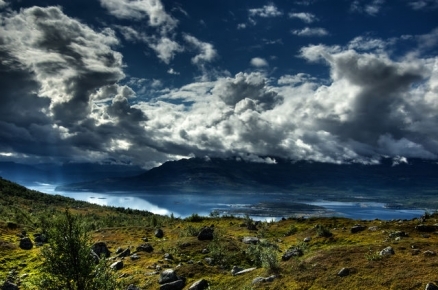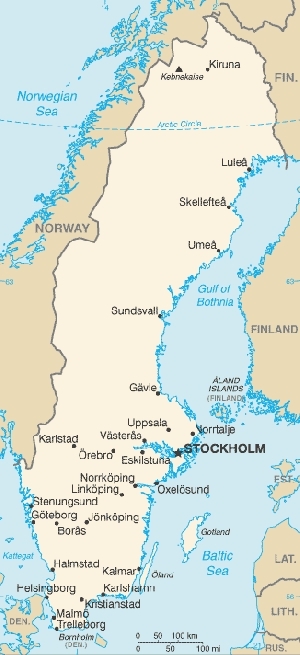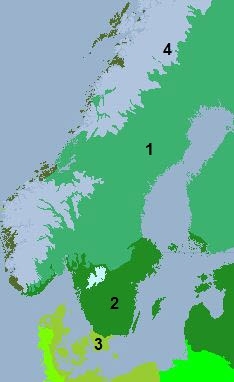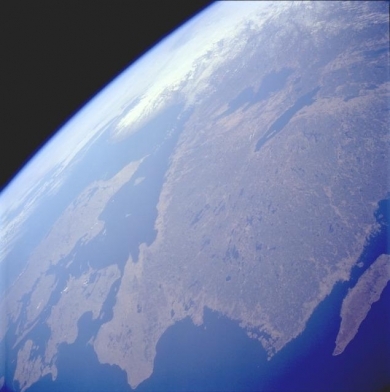Sweden (About the EoE)
Contents
Sweden
Countries and Regions of the World Collection  Sweden is a nation of none million people in northern Europe, bordering the Baltic Sea, Gulf of Bothnia, Kattegat, and Skagerrak, between Finland and Norway.
Sweden is a nation of none million people in northern Europe, bordering the Baltic Sea, Gulf of Bothnia, Kattegat, and Skagerrak, between Finland and Norway.
It has a strategic location along Danish Straits linking Baltic and North (North Sea) Seas.
Its major environmental issues include:
- acid rain damage to soils and lakes; and,
- pollution of the North Sea and the Baltic Sea
Sweden is susceptible to ice floes in the surrounding waters, especially in the Gulf of Bothnia, which can interfere with maritime traffic.
A military power during the 17th century, Sweden has not participated in any war for almost two centuries. An armed neutrality was preserved in both world wars.
Sweden's long-successful economic formula of a capitalist system interlarded with substantial welfare elements was challenged in the 1990s by high unemployment and in 2000-02 and 2009 by the global economic downturns, but fiscal discipline over the past several years has allowed the country to weather economic vagaries.
Sweden joined the European Union in 1995, but the public rejected the introduction of the euro in a 2003 referendum.
Geography
Location: Northern Europe, bordering the Baltic Sea, Gulf of Bothnia, Kattegat, and Skagerrak, between Finland and Norway
Geographic Coordinates: 62 00 N, 15 00 E
Area: 450,295 sq km (land: 410,335 sq km; water: 39,960 sq km)
Land Boundaries: 2,233 km (Finland 614 km, Norway 1,619 km)
Coastline: 3,218 km
Maritime Claims:
territorial sea: 12 nm (adjustments made to return a portion of straits to high seas)
exclusive economic zone: agreed boundaries or midlines
continental shelf: 200 m depth or to the depth of exploitation
Natural Hazards: ice floes in the surrounding waters, especially in the Gulf of Bothnia, can interfere with maritime traffic
Terrain: mostly flat or gently rolling lowlands; mountains in west. The highest point is Kebnekaise (2,111 m) and the lowest point is the reclaimed bay of Lake Hammarsjon, near Kristianstad (-2.4 m)
Climate: temperate in south with cold, cloudy winters and cool, partly cloudy summers; subarctic in north
Ecology and Biodiversity
|
1. Scandinavian and Russian taiga spreads across a wide expanse of landscape in Scandinavia and northern Russia within the boreal forests/taiga zone. It covers most of Sweden north of the Sarmatic mixed forests and east of the mountains. 2. Sarmatic mixed forests are spread over a large area of northern Europe and the Ural area of Russia. In Sweden, they cover the south of the country 3. Baltic mixed forests occupy a very small area in the extreme south of Sweden rimmed by the Baltic Sea. 4. Scandinavian montane birch forests and grasslands follows the Scandinavian Mountains, and the ecoregion as a whole continues into Norway and Finland.ncludes extensive unvegetated areas as well as dwarf birch forests See also:
|
People and Society
Population: 9,103,788 (July 2012 est.)
|
Spring has pushed winter back to the northern coastline of Norway (top left) and the higher elevations of Sweden (left), and this MODIS image from May 29, 2002, shows the rugged coastline still blanketed in snow. To the northwest (upper left ) lie the open waters of the Norwegian Sea and to the northeast (upper right), the Barents Sea. Finland is in the center of the image, and it's easy to see that the south is more heavily developed than the north. In the high-resolution imagery, it is easy to locate Helsinki, about half way up the north shore of the Gulf of Finland. To the east (right) is the beginning of the Russian Federation. MODIS has detected several fires burning throughout Scandinavia in this image. Source: NASA. Credit: Jacques Descloitres, MODIS Land Rapid Response Team, NASA/GSFC |
| Southern Sweden, with its plethora of lakes, is visible in this west-looking, high-oblique photograph. The lakes were created when the continental glaciers scoured this area and then receded, allowing the countless depressions to fill with water. In addition to numerous smaller lakes that are generally aligned in a north-south orientation, two large lakes - larger Lake Vanern and Lake Vattern - can be seen toward the northern edge of the photograph. The dark green area inland from the coast is forested lands. Image courtesy of NASA. |
Sweden has one of the world's longest life expectancies and lowest birth rates. The country counts at least 20,000 indigenous Sami among its population. About one in every nine Swedes is an immigrant or has at least one foreign-born parent. The largest immigrant groups are from Finland, Iraq, Serbia, Montenegro, Bosnia and Herzegovina, Somalia, Iran, Turkey, Norway, Denmark, and Poland. This reflects Nordic immigration, earlier periods of labor immigration, and more recent refugee and family immigration.
Swedish is a Germanic language related to Danish and Norwegian but different in pronunciation and orthography. English is widely spoken, particularly by Swedes under the age of 50.
Sweden has an extensive child-care system that guarantees a place for all young children ages one through six in a public day-care facility. From ages seven to 16, children participate in compulsory education. After completing the ninth grade, 90% attend upper secondary school for either academic or technical education.
Swedes benefit from an extensive social welfare system, which provides childcare and maternity and paternity leave, a ceiling on health care costs, old-age pensions, and sick leave, among other benefits. Parents are entitled to a total of 480 days' paid leave at 80% of a government-determined salary cap between birth and the child's eighth birthday. The parents may split those days however they wish, but 60 of the days are reserved specifically for the father. The parents may also take an additional 5 months of unpaid leave.
Ethnic Groups: indigenous population: Swedes with Finnish and Sami minorities; foreign-born or first-generation immigrants: Finns, Yugoslavs, Danes, Norwegians, Greeks, Turks
Age Structure:
0-14 years: 15.4% (male 722,558/female 680,933)
15-64 years: 64.8% (male 2,982,268/female 2,910,135)
65 years and over: 19.7% (male 800,169/female 992,665) (2011 est.)
Population Growth Rate: 0.168% (2012 est.)
Birthrate: 10.24 births/1,000 population (2012 est.)
Death Rate: 10.21 deaths/1,000 population (July 2012 est.)
Net Migration Rate: 1.65 migrant(s)/1,000 population (2011 est.)
Life Expectancy at Birth: 81.18 years
male: 78.86 years
female: 83.63 years (2012 est.)
Total Fertility Rate: 1.67 children born/woman (2012 est.)
Languages: Swedish (official), small Sami- and Finnish-speaking minorities
Literacy (age 15 and over can read and write): 99% (2003 est.)
Urbanization: 85% of total population (2010) growing at an annual rate of chnage of 0.6% (2010-15 est.)
History
During the seventh and eighth centuries, the Swedes were merchant seamen well known for their far-reaching trade. In the ninth century, Nordic Vikings raided and ravaged the European continent as far as the Black and Caspian Seas. During the 11th and 12th centuries, Sweden gradually became a unified Christian kingdom that later included Finland. Queen Margaret of Denmark united all the Nordic lands in the "Kalmar Union" in 1397. Continual tension within the countries and within the union gradually led to open conflict between the Swedes and the Danes in the 15th century. The union's final disintegration in the early 16th century brought on a long-lived rivalry between Norway and Denmark on one side and Sweden and Finland on the other.
In the 16th century, Gustav Vasa fought for an independent Sweden, crushing an attempt to restore the Kalmar Union and laying the foundation for modern Sweden. At the same time, he broke with the Catholic Church and established the Reformation. During the 17th century, after winning wars against Denmark, Russia, and Poland, Sweden-Finland (with scarcely more than 1 million inhabitants) emerged as a great power. Its contributions during the Thirty Years War under Gustav II Adolf (Gustavus Adolphus) determined the political as well as the religious balance of power in Europe. By 1658, Sweden ruled several provinces of Denmark as well as what is now Finland, Ingermanland (in which St. Petersburg is located), Estonia, Latvia, and important coastal towns and other areas of northern Germany.
Russia, Saxony-Poland and Denmark-Norway pooled their power in 1700 and attacked the Swedish-Finnish Empire. Although the young Swedish King Karl XII (also known as Charles XII) won spectacular victories in the early years of the Great Northern War, his plan to attack Moscow and force Russia into peace proved too ambitious; he fell in battle in 1718. In the subsequent peace treaties, the allied powers, joined by Prussia and England-Hanover, ended Sweden's reign as a great power.
Sweden suffered further territorial losses during the Napoleonic wars and was forced to cede Finland to Russia in 1809. The following year, the Swedish King's adopted heir, French Marshal Bernadotte, was elected Crown Prince as Karl Johan by the Riksdag (Parliament). In 1813, his forces joined the allies against Napoleon. The Congress of Vienna compensated Sweden for its lost German territory through a merger of the Swedish and Norwegian crowns in a dual monarchy. Sweden's last war was fought in 1814. A brief confrontation with Norway to restrain its demands for independence resulted in Norway entering into a union with Sweden, but with its own constitution and Parliament. The Sweden-Norway union was peacefully dissolved at Norway's request in 1905.
Sweden's predominantly agricultural economy shifted gradually from village to private, farm-based agriculture during the Industrial Revolution. This change failed to bring economic and social improvements commensurate with the rate of population growth; as a result about 1 million Swedes immigrated to the United States between 1850 and 1890.
In the 19th century liberal economic influences emerged, which ultimately led to the abolition of guild monopolies in favor of free enterprise. Other modernizing reforms included new taxation laws, voting reforms, and a national military service. This period of time also marked the birth of Sweden's three major political parties: the Social Democratic, Liberal and Conservative parties.
During and after World War I, in which Sweden remained neutral, the country benefited from the worldwide demand for Swedish steel, ball bearings, wood pulp, and matches. Postwar prosperity provided the foundations for the social welfare policies characteristic of modern Sweden. Foreign policy concerns in the 1930s centered on Soviet and German expansionism, which stimulated abortive efforts at Nordic defense cooperation. Sweden followed a policy of armed neutrality during World War II and currently remains nonaligned.
Sweden became a member of the European Union (EU) in 1995. In September 2003 Sweden held a referendum on entering the European Monetary Union. The Swedish people rejected participation, with 56% voting against and 42% for. No new referendum is currently planned.
Foreign Relations
For much of the last 2 centuries, Swedish foreign policy had been based on the premise that national security was best served by staying out of military alliances in peacetime in order to remain neutral in the event of war. However, Sweden has been redefining this position in recent years. Sweden aspires to be at the core of the European Union. In a 2009 unilateral declaration, Sweden said it would not remain passive if another EU member state or Nordic country suffers a disaster or an attack. Internationally, the Swedish Government gives special focus to disarmament, arms control, and nuclear nonproliferation. Sweden has greatly contributed to numerous international peacekeeping operations under UN, EU, and NATO auspices, including the NATO-led peacekeeping forces in the Balkans (KFOR). The country contributes to the International Security Assistance Force (ISAF) in Afghanistan, and in March 2006 assumed leadership of the Provincial Reconstruction Team in Mazar-e-Sharif, which was recently re-named a Transitional Support Team (TST) to reflect the transition in Afghanistan from military to civilian-led assistance. Sweden currently has about 500 troops deployed with ISAF. Sweden also has troops serving in Kosovo (KFOR) and in the EU anti-piracy mission ATLANTA off the coast of Somalia. Sweden also participated in Operation Unified Protector over Libya in 2011.
Government
Government Type: constitutional monarchy
Sweden's government is a limited constitutional monarchy with a parliamentary system. The head of state is the monarch, whose authority is symbolic and representational. King Carl XVI Gustaf (Bernadotte) ascended to the throne on September 15, 1973. Sweden has three levels of government: national, regional, and local. Parliamentary, municipal, and county council elections are held every 4 years. In addition, there is a European level, which has acquired increasing importance following Sweden's entry into the EU and the EU’s adoption of the Lisbon Treaty.
Popular government in Sweden rests upon ancient tradition. The Swedish Parliament (Riksdag) stems from tribal courts (Ting) and the election of kings during the Viking era. It became a permanent institution in the 15th century. The 349-member unicameral Riksdag has legislative powers, and is in session generally from September through mid-June. Speaker of Parliament is the country's highest-ranking elective office.
Executive authority is vested in the Cabinet, which consists of a prime minister (head of government) and 22 ministers who run the governmental departments. Proposals for new laws are presented by the government, which also implements decisions made by the Riksdag. The government is assisted in its work by the Government Offices, comprising a number of ministries, and some 300 central government agencies and public administrations. The current "Alliance" government, led by Prime Minister Fredrik Reinfeldt, came to power in September 2006 and was re-elected in September 2010.
Ordinary general elections to the Swedish Parliament are held every fourth year on the third Sunday in September. County council and municipal council elections take place at the same time. A party must receive at least 4% of the votes in the entire country or 12% in a single electoral district to qualify for any seats in Parliament.
Capital: Stockholm - 1.279 million (2009)
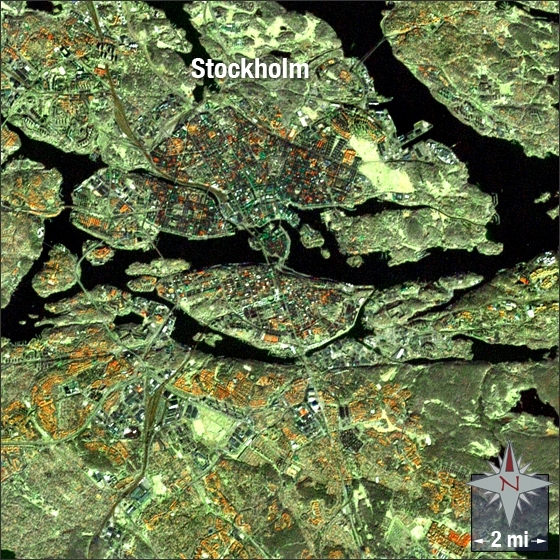
The city of Stockholm located on the east cost of central Sweden has a long history. Stockholm was originally known as Agnafit in Norse stories (sagas). The name Stockholm dates from 1252, when it became an important site in the iron trade. Stockholm is the capital and largest city of Sweden with an estimated population of 851,155.
In this image Stockholm appears tan, grey, and red. Water is black and vegetation is green.
This Landsat 7 image was acquired September 24, 2000. It is a true color pan-sharpened image using ETM+ bands 3, 2, 1 and the panchromatic band. The addition of the panchromatic band sharpens the spatial resolution of the image (to 15m/pixel), but can effect the color quality; notice that the greens looks somewhat “minty” and the city appears more “bejeweled” than it would without the pan-sharpening process. Stockholm falls on Landsat WRS-2 Path192 Row 19. Source: NASA
 Administrative divisions: Sweden is divided into 21 counties (lan), 18 county councils (landsting), 290 municipalities (kommuner), and two semi-independent regions. Each county is headed by a governor, who is appointed by the central government. The counties coordinate administration with national political goals for the county. The county council (landsting) is a regional government that is popularly elected with particular responsibility for health and medical care. The municipalities are local governments that deal with issues such as education, public transportation and social welfare. Elected municipal councils are headed by executive committees roughly analogous to the boards of commissioners found in some U.S. cities.
Administrative divisions: Sweden is divided into 21 counties (lan), 18 county councils (landsting), 290 municipalities (kommuner), and two semi-independent regions. Each county is headed by a governor, who is appointed by the central government. The counties coordinate administration with national political goals for the county. The county council (landsting) is a regional government that is popularly elected with particular responsibility for health and medical care. The municipalities are local governments that deal with issues such as education, public transportation and social welfare. Elected municipal councils are headed by executive committees roughly analogous to the boards of commissioners found in some U.S. cities.
21 counties (lan, singular and plural);
- Blekinge (K)
- Dalarna (W)
- Gavleborg (X)
- Gotland (I)
- Halland (N)
- Jamtland, (Z)
- Jonkoping (F)
- Kalmar (H)
- Kronoberg (G)
- Norrbotten (BD)
- Orebro (T)
- Ostergotland (E)
- Skane (M)
- Sodermanland (D)
- Stockholm (AB)
- Uppsala (C)
- Varmland (S)
- Vasterbotten (AC)
- Vasternorrland (Y)
- Vastmanland (U)
- Vastra Gotaland (O)
Independence Date: 6 June 1523 (Gustav VASA elected king)
Legal System: Swedish law draws upon Germanic and Roman traditions. It is neither as codified as French law nor as dependent on judicial precedent as U.S. law. Legislative and judicial institutions include, in addition to the Riksdag, the Supreme Court, the Supreme Administrative Court, the Labor Court, the Law Council, District Courts and Courts of Appeal, and the Public Prosecutor's Office. The parliamentary ombudsmen and the Chancellor of Justice oversee the application of laws with particular attention to abuses of authority. Sweden accepts compulsory International Court of Justice (ICJ) jurisdiction; and accepts International criminal court (ICCt) jurisdiction
International Environmental Agreements
Sweden is party to international agreements on: Air Pollution, Air Pollution-Nitrogen Oxides, Air Pollution-Persistent Organic Pollutants, Air Pollution-Sulfur 85, Air Pollution-Sulfur 94, Air Pollution-Volatile Organic Compounds, Antarctic-Environmental Protocol, Antarctic-Marine Living Resources, Antarctic Treaty, Biodiversity, Climate Change, Climate Change-Kyoto Protocol, Desertification, Endangered Species, Environmental Modification, Hazardous Wastes, Law of the Sea, Marine Dumping, Ozone Layer Protection, Ship Pollution, Tropical Timber 83, Tropical Timber 94, Wetlands, and Whaling.
Water
Total Renewable Water Resources: 179 cu km (2005)
Freshwater Withdrawal: 2.68 cu km/yr (37% domestic, 54% industrial, 9% agricultural)
Per Capita Freshwater Withdrawal: 296 cu m/yr (2002)
Agriculture
Agricultural products: barley, wheat, sugar beets; meat, milk
Irrigated Land: 1,600 sq km (2008)
Resources
Natural Resources: iron ore, copper, lead, zinc, gold, silver, tungsten, uranium, arsenic, feldspar, timber, hydropower
Land Use:
Economy
Aided by peace and neutrality for the whole of the 20th century, Sweden has achieved an enviable standard of living under a mixed system of high-tech capitalism and extensive welfare benefits. It has a modern distribution system, excellent internal and external communications, and a skilled labor force. In September 2003, Swedish voters turned down entry into the euro system concerned about the impact on the economy and sovereignty. Timber, hydropower, and iron ore constitute the resource base of an economy heavily oriented toward foreign trade. Privately owned firms account for about 90% of industrial output, of which the engineering sector accounts for 50% of output and exports. Agriculture accounts for little more than 1% of GDP and of employment.
Until 2008, Sweden was in the midst of a sustained economic upswing, boosted by increased domestic demand and strong exports. This and robust finances offered the center-right government considerable scope to implement its reform program aimed at increasing employment, reducing welfare dependence, and streamlining the state's role in the economy.
Despite strong finances and underlying fundamentals, the Swedish economy slid into recession in the third quarter of 2008 and growth continued downward in 2009 as deteriorating global conditions reduced export demand and consumption. Strong exports of commodities and a return to profitability by Sweden's banking sector drove the strong rebound in 2010.
The Swedish economy emerged from the financial crisis as one of the strongest in Europe. A high-tech economy and a comprehensive system of welfare benefits allow Sweden to enjoy one of the highest standards of living in the world. Sweden has one of the most globalized and competitive economies today.
From the early 1990s until 2008, Sweden enjoyed a sustained economic upswing fueled by strong exports and rising domestic demand. In the fourth quarter of 2008, Sweden entered a recession. Exports account for 50% of Swedish GDP, and its mix of exports are the type of capital goods customers stop buying at the onset of a recession, and are quick to resume buying once growth returns. Heavily dependent on exports of autos, telecommunications, construction equipment, and other investment goods, Sweden was hit hard by the contraction in external demand due to the global financial and economic crisis. As a result, GDP fell 4.9% in 2009. Other main Swedish exports include machinery and transport equipment, chemical and rubber products, food, clothing, textiles and furniture, and wood products. The Swedish Government is expanding its export base away from the traditionally European market, seeking to grow in Asia, South America, and the United States.
Sweden’s GDP grew by 5.5% in 2010, beating expectations and setting growth records. The Swedish economy maintained a similar pace in 2011 with third-quarter growth at 4.6%. However, growth projections for the next couple of years were repeatedly revised downward throughout 2011 as the European economy (Sweden’s main export market) contracted. As of February 2012, the Central Bank was projecting growth of only 0.7% for 2012. Both the government and Central Bank expect normal growth rates to return in 2013, assuming the eurozone financial crisis abates. (As of February 2012, the Central Bank projected 2.1% growth in 2013 and 3.2% growth in 2014.)
Central Bank policy is guided by inflation targeting to keep the Consumer Price Index (CPI) at or around 2% on an annual basis. The Central Bank has been steadily lowering rates over the past 6 months to stimulate the economy. The rate currently sits at 1.5%.
One of Sweden’s tools in maintaining solid public finances is a budget process that calls for parliamentary-designated spending ceilings. The ceilings were set for SEK 1.024 trillion (U.S. $144.7 billion) in 2010 and SEK 1.063 trillion (U.S. $150.3 billion) in 2011, and are SEK 1.083 trillion (U.S. $153.1 billion) in 2012 and SEK 1.093 trillion (U.S. $154.5 billion) in 2013. While spending ceilings can technically be surpassed, they represent a promise the government makes to the people, and they are adhered to.
Sweden entered the 2008 financial crisis with a budget surplus due to prior economic growth and conservative fiscal policy. This key factor allowed Sweden to ride out the crisis better than most other economies. In 2008, Sweden had a surplus of SEK 58 billion (U.S. $8.2 billion). By 2009, the surplus dipped into a deficit of SEK 176 billion (U.S. $24.8 billion). The budget showed only a slight deficit for 2010, and went into surplus by November 2011. The Swedish Government released a conservative budget for 2012 aimed at maintaining a surplus and ensuring that Sweden has safety margins in case of a protracted global economic downturn. The goal of the 2012 budget is to counter the slowdown in the labor market and strengthen prospects for long-term employment, growth, and entrepreneurship while also ensuring that the core elements of the welfare system are strong.
The Swedish banking sector is highly concentrated, with the four large banking groups (Nordea, Svenska Handelsbanken, Swedbank, and SEB) accounting for roughly 80% of sector assets. Swedish banks are heavily invested in the Baltic states, some of the countries hardest hit during the 2008 financial crisis. Swedish banks suffered considerably as a result, forcing authorities to respond with a bank support package in 2008. The package included guarantees for new debt insurance, increased deposit insurance, and a fund that would provide up to $6 billion in equity injection to systemically important institutions. In August 2010, the government revoked the license of the embattled HQ Bank, as risky securities deals and an over-valued trading portfolio threatened its survival. The bank was subsequently purchased by investment bank Carnegie. Despite this, the Swedish banking industry is strong. All Swedish banks have passed EU stress tests with wide margins. Swedish banks are far less exposed to the current financial crisis because they do not hold large amounts of debt from Greece, Spain, Portugal, and Italy.
Unemployment is slowly falling, and was at 7.1% as of December 2011. The government projects a small increase in unemployment in 2012 and 2013 followed by a leveling off of the rate at 5.5% by 2015. Youth unemployment is disproportionately high at around 20.8% for those between 15 and 24. The 2012 budget includes programs designed to better prepare young people to enter the work force and bring the economy into full employment.
Over 70% of the Swedish labor force is unionized; however, membership is decreasing. For most unions there is a counterpart employers' organization for businesses. The unions and employer organizations are independent of both the government and political parties, although the largest federation of unions, the National Swedish Confederation of Trade Unions (LO), always has maintained close links to the largest political party, the Social Democrats. There is no national minimum wage. Instead, wages are set by collective bargaining.
The World Bank ranked Sweden 18th in “ease of doing business” and 43rd in “ease of starting a business” in 2010. Starting a business in Sweden takes 15 days and costs 0.57% of GNI per capita. The World Bank ranking data set included 183 economies worldwide, including 27 Organization for Economic Cooperation and Development (OECD) high-income economies. As of 2009, there were 1,100 American companies operating in Sweden. American companies in Sweden employed 101,700 Swedes in 2008--the largest number of employees of all foreign countries doing business in Sweden. The majority of employees in Swedish-controlled affiliates abroad are in Europe and America, although the number of employees in America was decreasing as of 2008.
GDP: (Purchasing Power Parity): $379.4 billion (2011 est.)
GDP: (Official Exchange Rate): $571.6 billion (2011 est.)
GDP- per capita (PPP): $40,600 (2011 est.)
GDP- composition by sector:
agriculture: 1.9%
industry: 26.6%
services: 71.5% (2010 est.)
Industries: iron and steel, precision equipment (bearings, radio and telephone parts, armaments), wood pulp and paper products, processed foods, motor vehicles
Currency: Swedish kronor (SEK)
See: Oil phase-out in Sweden
